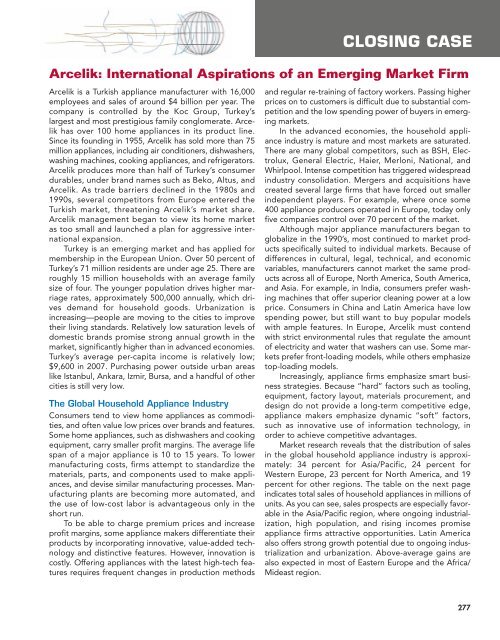Understanding Emerging Markets
Understanding Emerging Markets
Understanding Emerging Markets
You also want an ePaper? Increase the reach of your titles
YUMPU automatically turns print PDFs into web optimized ePapers that Google loves.
CAVUMC09_254-283hr 10/15/07 4:56 PM Page 277<br />
CLOSING CASE<br />
Arcelik: International Aspirations of an <strong>Emerging</strong> Market Firm<br />
Arcelik is a Turkish appliance manufacturer with 16,000<br />
employees and sales of around $4 billion per year. The<br />
company is controlled by the Koc Group, Turkey’s<br />
largest and most prestigious family conglomerate. Arcelik<br />
has over 100 home appliances in its product line.<br />
Since its founding in 1955, Arcelik has sold more than 75<br />
million appliances, including air conditioners, dishwashers,<br />
washing machines, cooking appliances, and refrigerators.<br />
Arcelik produces more than half of Turkey’s consumer<br />
durables, under brand names such as Beko, Altus, and<br />
Arcelik. As trade barriers declined in the 1980s and<br />
1990s, several competitors from Europe entered the<br />
Turkish market, threatening Arcelik’s market share.<br />
Arcelik management began to view its home market<br />
as too small and launched a plan for aggressive international<br />
expansion.<br />
Turkey is an emerging market and has applied for<br />
membership in the European Union. Over 50 percent of<br />
Turkey’s 71 million residents are under age 25. There are<br />
roughly 15 million households with an average family<br />
size of four. The younger population drives higher marriage<br />
rates, approximately 500,000 annually, which drives<br />
demand for household goods. Urbanization is<br />
increasing—people are moving to the cities to improve<br />
their living standards. Relatively low saturation levels of<br />
domestic brands promise strong annual growth in the<br />
market, significantly higher than in advanced economies.<br />
Turkey’s average per-capita income is relatively low;<br />
$9,600 in 2007. Purchasing power outside urban areas<br />
like Istanbul, Ankara, Izmir, Bursa, and a handful of other<br />
cities is still very low.<br />
The Global Household Appliance Industry<br />
Consumers tend to view home appliances as commodities,<br />
and often value low prices over brands and features.<br />
Some home appliances, such as dishwashers and cooking<br />
equipment, carry smaller profit margins. The average life<br />
span of a major appliance is 10 to 15 years. To lower<br />
manufacturing costs, firms attempt to standardize the<br />
materials, parts, and components used to make appliances,<br />
and devise similar manufacturing processes. Manufacturing<br />
plants are becoming more automated, and<br />
the use of low-cost labor is advantageous only in the<br />
short run.<br />
To be able to charge premium prices and increase<br />
profit margins, some appliance makers differentiate their<br />
products by incorporating innovative, value-added technology<br />
and distinctive features. However, innovation is<br />
costly. Offering appliances with the latest high-tech features<br />
requires frequent changes in production methods<br />
and regular re-training of factory workers. Passing higher<br />
prices on to customers is difficult due to substantial competition<br />
and the low spending power of buyers in emerging<br />
markets.<br />
In the advanced economies, the household appliance<br />
industry is mature and most markets are saturated.<br />
There are many global competitors, such as BSH, Electrolux,<br />
General Electric, Haier, Merloni, National, and<br />
Whirlpool. Intense competition has triggered widespread<br />
industry consolidation. Mergers and acquisitions have<br />
created several large firms that have forced out smaller<br />
independent players. For example, where once some<br />
400 appliance producers operated in Europe, today only<br />
five companies control over 70 percent of the market.<br />
Although major appliance manufacturers began to<br />
globalize in the 1990’s, most continued to market products<br />
specifically suited to individual markets. Because of<br />
differences in cultural, legal, technical, and economic<br />
variables, manufacturers cannot market the same products<br />
across all of Europe, North America, South America,<br />
and Asia. For example, in India, consumers prefer washing<br />
machines that offer superior cleaning power at a low<br />
price. Consumers in China and Latin America have low<br />
spending power, but still want to buy popular models<br />
with ample features. In Europe, Arcelik must contend<br />
with strict environmental rules that regulate the amount<br />
of electricity and water that washers can use. Some markets<br />
prefer front-loading models, while others emphasize<br />
top-loading models.<br />
Increasingly, appliance firms emphasize smart business<br />
strategies. Because “hard” factors such as tooling,<br />
equipment, factory layout, materials procurement, and<br />
design do not provide a long-term competitive edge,<br />
appliance makers emphasize dynamic “soft” factors,<br />
such as innovative use of information technology, in<br />
order to achieve competitive advantages.<br />
Market research reveals that the distribution of sales<br />
in the global household appliance industry is approximately:<br />
34 percent for Asia/Pacific, 24 percent for<br />
Western Europe, 23 percent for North America, and 19<br />
percent for other regions. The table on the next page<br />
indicates total sales of household appliances in millions of<br />
units. As you can see, sales prospects are especially favorable<br />
in the Asia/Pacific region, where ongoing industrialization,<br />
high population, and rising incomes promise<br />
appliance firms attractive opportunities. Latin America<br />
also offers strong growth potential due to ongoing industrialization<br />
and urbanization. Above-average gains are<br />
also expected in most of Eastern Europe and the Africa/<br />
Mideast region.<br />
277

















